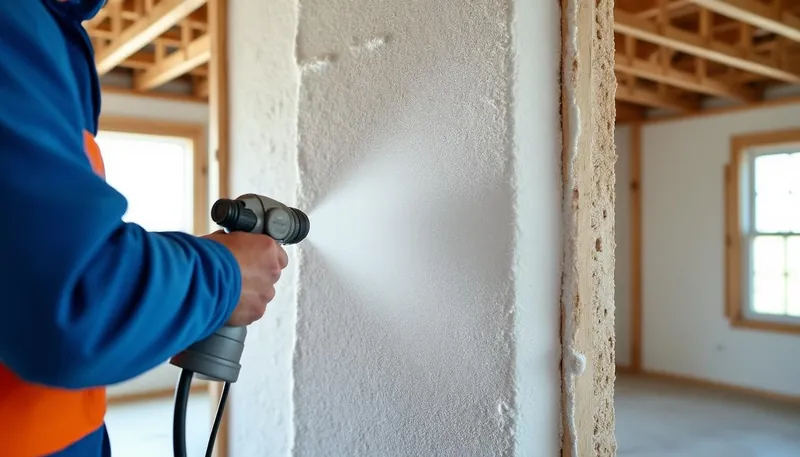Foam insulation has become a game changer in the world of energy efficiency, significantly impacting a home’s energy rating or Energy Performance Certificate (EPC). With rising energy costs and increasing environmental awareness, improving your EPC rating isn’t just a good idea; it’s a necessity. Foam insulations, like Icynene, Johns Manville, and Owens Corning, offer superior thermal performance and airtightness, which are crucial for energy conservation. These materials not only minimize heat loss but also help create a comfortable living environment year-round.
As we step further into 2025, the push for energy-efficient homes is stronger than ever. Local regulations often mandate more robust energy-efficiency measures, making it crucial for homeowners to understand how foam insulation systems can dramatically boost their EPC ratings. In essence, these insulation types not only pay off in reduced energy bills but also enhance property value and comfort. All of this wraps up into one compelling narrative: foam insulation isn’t just about comfort; it’s an investment in sustainability and efficiency that pays dividends long into the future.
- 🔹 Foam insulation reduces air leakage for improved energy efficiency.
- 🔹 The right insulation can lower heating and cooling costs, contributing to overall expenditure reduction.
- 🔹 Higher EPC ratings can often lead to improved property values and marketability.
- 🔹 Eco-friendly variants are available that contribute to sustainability efforts.
- 🔹 Proper installation is key to realizing the benefits of foam insulation.
Understanding EPC Ratings and Their Importance for Homeowners
Energy Performance Certificates (EPC) provide crucial information about the energy efficiency of a home. They contain ratings from A (most efficient) to G (least efficient). The ratings take into account various factors, including insulation quality, heating systems, and energy consumption patterns. A high EPC rating signifies a well-insulated and energy-efficient property, while a low EPC rating indicates unnecessary energy loss and higher utility costs.
So, why should homeowners care? Well, several reasons substantiate the significance of EPC ratings:
- 📈 Properties with higher EPC ratings are often more appealing to buyers, making them easier to sell or lease.
- 🌳 Properties with good energy ratings can benefit from lower energy bills, translating to substantial long-term savings.
- 💡 Improved EPC ratings can sometimes qualify homeowners for grants or financial incentives aimed at increasing energy efficiency.
- 🏡 A well-insulated home contributes to a more comfortable living space, reducing nagging drafts and other climate control issues.
Overall, homeowners looking to improve their EPC rating should strongly consider insulated solutions like foam. However, not all insulation is created equal. The choice between different types of foam insulation, including rigid panels like XPS and EPS, or flexible options like spray foam, can also impact how significantly a property’s EPC rating can be boosted.
The Role of Foam Insulation in Reducing Energy Consumption
Foam insulation excels in creating a thermal barrier that reduces heat exchange between the interior and exterior of the home. Homes tend to lose heat in winter and absorb it in summer, leading to increased HVAC system usage—a significant contributor to energy bills. Properly installed foam insulation can drastically reduce this heat transfer. The closed-cell structures of these materials seal gaps and cracks, effectively stopping air leakage which is often a silent energy expense.
Consider this: without insulation, up to 40% of your home’s energy may be wasted through air leaks. Foam insulation works wonders in minimizing this issue:
- 🏠 Creates an airtight seal to prevent drafts and unwanted air exchange.
- 🌡️ Maintains a stable indoor temperature, reducing the burden on heating and cooling systems.
- 💧 Offers moisture resistance, preventing damage from condensation and enhancing indoor air quality.
Manufacturers like CertainTeed and Kingspan have developed innovative products designed specifically for energy efficiency. By properly insulating critical areas—including attics, walls, and basements—you can lower your home’s U-value, which is a measure of heat loss, thereby improving your EPC score.
Types of Foam Insulation and Their Unique Benefits
When it comes to foam insulation, there are several options to consider: Extruded Polystyrene (XPS), Expanded Polystyrene (EPS), Polyisocyanurate (Polyiso), and spray foam. Each has its own set of advantages and ideal applications depending on the unique requirements of your home. Let’s break ‘em down:
| Type | R-Value per Inch | Best Uses | Pros | Cons |
|---|---|---|---|---|
| Extruded Polystyrene (XPS) | 5.0 | Beneath slabs and exterior walls | Excellent moisture resistance | Less cost-effective than EPS |
| Expanded Polystyrene (EPS) | 3.8 – 4.2 | Above-grade walls | Cost-effective solution | More susceptible to moisture |
| Polyisocyanurate (Polyiso) | 6.0 – 6.5 | Commercial roofs | Highest thermal efficiency | Can lose effectiveness in extreme cold |
| Spray Foam | 6.0 – 7.0 | Cavities and complex geometries | Expands to fill all gaps | Generally requires professional installation |
Selecting the right type of foam insulation is crucial, as each variant serves specific objectives. Choosing materials from reputable manufacturers like BASF or Demilec ensures you get the highest-quality products, maximizing your investment in energy efficiency.
Steps to Enhance Your Home’s EPC with Foam Insulation
Enhancing your EPC rating through foam insulation involves not just installation, but a strategic approach to energy efficiency. Here are the essential steps:
- 🔧 Conduct an energy audit to identify weak insulation areas in your home.
- 📝 Choose the right type of foam insulation for each area of your home.
- 👷♂️ Hire professional services for installation or carry out proper DIY techniques.
- 💡 Seal any air leaks, including around windows and doors.
- 📊 Monitor your energy usage patterns post-installation to evaluate the improvements.
Addressing these factors ensures that the foam insulation you incorporate works most effectively, leading to an optimal EPC rating and significant energy cost savings.
Long-Term Benefits of Improved EPC Ratings with Foam Insulation
Boosting your home’s EPC rating using foam insulation not only helps you save money on energy bills but improves the overall longevity and market value of a property. Indeed, homes with better energy performance ratings benefit from numerous advantages:
- 🌍 Environmental Impact: A home that requires less energy reduces its carbon footprint.
- 🏘️ Enhanced Property Value: Homebuyers are drawn to properties with high EPC ratings, often willing to pay a premium.
- 🔒 Comfort: Continual comfort with fewer temperature fluctuations enhances living quality.
- 💵 Long-Term Savings: Reduced energy costs can amount to substantial savings over time.
Ultimately, the upfront investment in foam insulation pays off not only through energy savings but also through improved overall living conditions. Manufacturers like Knauf Insulation and ROCKWOOL are at the forefront, providing innovative solutions to help homeowners achieve these positive outcomes.
Summary of Foam Insulation Impact on EPC Ratings
In summary, the impact of foam insulation on a home’s EPC rating cannot be overstated. By understanding different types of foam, their application, and long-term benefits, homeowners can make informed decisions that lead to enhanced energy efficiency, lower costs, and greater comfort in their homes.
How much can foam insulation improve my EPC rating?
The improvement can vary widely but can increase ratings significantly, moving a home from D to B ratings in many cases.
What is the lifespan of foam insulation?
Foam insulation can last for several decades (50+ years) if installed and maintained correctly.
Can I install foam insulation myself?
While some drywall enthusiasts manage minor installations, it’s often best left to professionals to ensure optimal performance.
What are the environmental impacts of foam insulation?
Modern foam boards often use eco-friendlier materials, helping reduce their carbon footprint over time.
What types of homes benefit most from foam insulation?
Most home types can benefit, but particularly older homes with poor insulation and air leakage.


